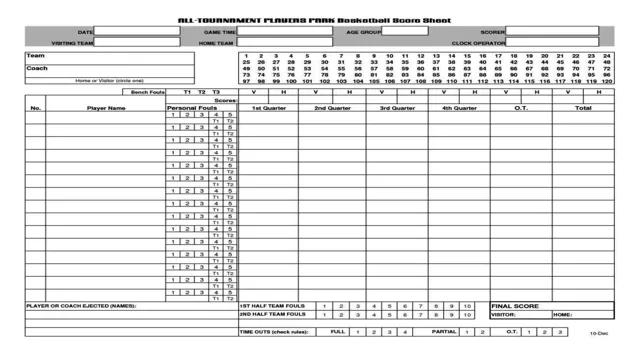Do you ever watch a basketball game and wonder what all those numbers mean? Well, you’re not alone. Basketball stats can be overwhelming, but learning the basics can be a game-changer. Basketball Stats 101 is all about understanding the numbers that make up the game.
From points and rebounds to assists and turnovers, every stat tells a story. Think of it like a puzzle – each number adds a piece to the overall picture. Understanding basketball stats can help you appreciate the game on a deeper level and even improve your own skills.
So, grab a seat and let’s dive into the world of basketball stats.
What is a basketball stat?
Basketball stat, for short, refers to statistical data that is used to analyze and evaluate the performance of basketball players, teams, and even games. These stats help identify players’ strengths and weaknesses, track a team’s progress, and make strategic decisions during games. There are a variety of basketball stats that can be tracked, such as points scored, rebounds, assists, turnovers, steals, blocks, and shooting percentage.
However, not all stats are created equal—some are more important than others depending on the context. For instance, a player’s shooting percentage may be less useful if they are known for being a defensive powerhouse. Additionally, some stats may be highly correlated, such as scoring and rebounding.
Understanding basketball stats requires a great deal of knowledge about the game, as well as careful analysis of the data. Nonetheless, these stats can be extremely useful for both players and coaches alike in making informed decisions regarding strategy and performance.
Defining statistics in basketball
Basketball stats are numerical values that represent different aspects of player performance during a game. These stats are used to measure a player’s ability in certain areas, such as shooting, scoring, rebounding, and defense. Whether you are a coach, player, or fan, understanding basketball stats is essential for evaluating player performance and determining the outcome of a game.
Stats such as points, rebounds, and assists are commonly used to measure a player’s offensive performance, while steals, blocks, and personal fouls are often used to measure defensive performance. Advanced stats such as player efficiency rating (PER) and true shooting percentage (TS%) have gained popularity in recent years, providing a more comprehensive view of a player’s contributions to the team. Overall, basketball stats are vital tools for analyzing the game, providing insights into individual and team performance that can help to inform decision-making and strategy.

The importance of stats in basketball
Basketball stats are integral to analyzing the performance of players and teams in the game of basketball. A basketball stat, short for statistic, is a numerical measurement of a specific aspect of a player or team’s performance. These stats are commonly used to evaluate various basketball skills, such as scoring, rebounding, and assists.
They are also used for trend analysis and predicting future outcomes. In basketball, stats are tracked in various ways, including traditional box scores and advanced analytics. These stats can help both casual fans and professionals understand the nuances of the game and the players who play it.
By using basketball stats, coaches, scouts, and players can make more informed decisions about how to improve their performance and the performance of their team. Overall, basketball stats play a crucial role in the game and continue to shape the way we understand basketball today.
Common basketball stats
When it comes to basketball, there are a variety of statistics that are used to measure individual and team performance. One of the most important basketball stats for short is points per game (PPG). This metric calculates the average number of points scored by a player per game and is commonly used to assess offensive efficiency.
Other commonly used stats include rebounds per game (RPG), which measures the average number of rebounds a player gathers per game. Then there’s assists per game (APG), which measures how many times a player sets up a teammate for a score per game. Another important stat is field goal percentage (FG%), which is the percentage of shots made by a player from the field.
All of these stats can help coaches and fans alike gain a better understanding of how players and teams are performing.
Points per game (PPG)
Points per game (PPG) is one of the most common basketball statistics used to measure a player’s scoring efficiency. Simply put, PPG is the average number of points a player scores per game throughout a season. A high PPG indicates that a player is a top scorer who consistently contributes to their team’s offensive output.
It’s an essential stat for coaches and scouts who use it to evaluate player performance and make strategic decisions. However, PPG doesn’t always tell the whole story. A player who scores a lot of points may not necessarily be an efficient scorer if they take too many shots or turn over the ball frequently.
So, while PPG is a helpful metric, it must be used in conjunction with other stats to get a more comprehensive assessment of a player’s performance.
Rebounds per game (RPG)
Rebounds per game (RPG) is a common basketball statistic used to measure a player’s ability to retrieve missed shots. It refers to the average number of rebounds a player grabs in a single game. RPG is an essential indicator of a player’s performance on the court and can determine their role within a team.
A high RPG can signify a player’s strength in the paint, where they can out-rebound their opponents and prevent second-chance opportunities. In contrast, a low RPG may suggest that a player struggles with positioning or lacks aggressiveness under the basket. Overall, RPG is one of the many critical stats used to evaluate a player’s impact on the game.
Assists per game (APG)
Assists are one of the most important aspects of basketball. It is a measure of how well a player can create an opportunity for their teammate to score. Assists per game (APG) is a common statistic used to evaluate a player’s ability to distribute the ball efficiently.
This statistic measures the average number of assists a player has over a game and can demonstrate how involved they are in the team’s scoring. Players who have a high APG are often considered great passers, capable of making precise and timely passes. However, it is important to note that APG is not the only measure of a player’s ability to assist.
Factors such as the number of possessions a player has, the team’s playing style, and their teammates’ effectiveness in converting the opportunities created by the player can all impact APG. Nevertheless, APG remains a valuable statistic that can help fans and coaches in evaluating a player’s performance.
Advanced basketball stats
Basketball stats can be a bit confusing sometimes, with seemingly endless acronyms and numbers to keep track of. One popular basketball stat for short is PER, which stands for Player Efficiency Rating. Essentially, PER is a measure of how effective a player is on the court by taking into account their positive contributions (points, rebounds, assists, etc.
) and subtracting negative ones (missed shots, turnovers, etc.) relative to the amount of playing time they get. PER takes all of these factors into consideration and produces a single number that represents a player’s overall efficiency.
It’s a great way to compare players across different positions and even different eras, as long as you understand the context behind the statistic. By incorporating advanced metrics like PER into our analysis of basketball players, we can gain a deeper understanding of their impact on the game and make more informed decisions about how to build winning teams.
Player Efficiency Rating (PER)
If you’re really into basketball, you must be familiar with the acronym PER, which stands for Player Efficiency Rating. Basically, it’s an advanced statistic that tries to measure how efficient a basketball player is on the court. It takes into account various factors like the number of points, rebounds, assists, steals, and blocks they get per game, as well as the number of shots they take and the minutes they play.
The formula is not that complicated, but it’s definitely not something you can calculate in your head. To put it simply, the higher a player’s PER, the better they are as a player. A score of 15 is average, while a score of 20 or higher is considered excellent.
Some of the NBA’s all-time greats like LeBron James and Michael Jordan have had PERs of 30 or higher in their prime, which just goes to show how dominant they were on the court. But just like any other advanced stat, it’s not the be-all and end-all of basketball. There are other important factors to consider like team dynamics, player tendencies, and game situations.
Nonetheless, PER is still a useful tool for evaluating a player’s overall impact and worth on the court.
True Shooting Percentage (TS%)
True Shooting Percentage (TS%) is an advanced basketball statistic that measures a player’s efficiency in scoring points. Unlike other shooting percentages, TS% takes into account the number of free throws attempted by the player. This statistic is the combination of field goal percentage, three-point field goal percentage, and free throw percentage.
TS% is an important indicator of a player’s overall performance and can be used to compare players’ efficiency. A high TS% means a player is an efficient scorer and can help their team win games. On the other hand, a low TS% might indicate that a player needs to work on their shooting accuracy or shot selection.
Overall, TS% is a useful metric for coaches, analysts, and fans to evaluate a player’s shooting performance and efficiency.
Conclusion
In conclusion, basketball is a game of numbers – but not just any numbers, basketball stats! These stats not only provide a way to analyze players and teams, but they also tell a story of the game, showcasing the athleticism, strategy, and heart that goes into every play. So the next time you’re watching a game, pay attention to the basketball stat for short and see how these numbers add up to create a thrilling and unforgettable experience on the court. Don’t just watch the game, appreciate the stats behind it!”
FAQs
What is the abbreviation for basketball stat?
The abbreviation for basketball stat is Bball stat.
How is the shooting percentage calculated in basketball stats?
The shooting percentage is calculated by dividing the number of baskets made by the number of shots taken and then multiplying the result by 100.
What is the difference between a turnover and a steal in basketball stats?
A turnover is when the player loses the ball before shooting or passing, while a steal is when the opposing team takes the ball from the player without them losing it.
What is the significance of free-throw percentage in basketball stats?
Free-throw percentage is an indicator of a player’s ability to score from the free-throw line. A high percentage suggests that the player can score reliably from this position, while a low percentage suggests the opposite.
What does the plus/minus statistic in basketball stats indicate?
The plus/minus statistic indicates the point differential when a specific player is on the court. A positive value suggests that the player contributes to the team’s success, while a negative value suggests the opposite.


